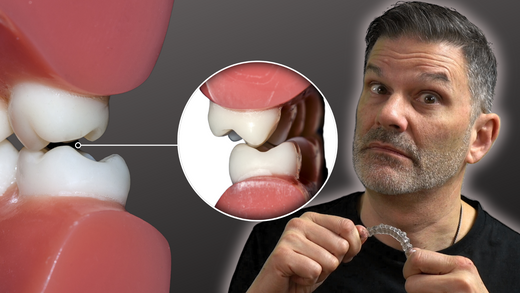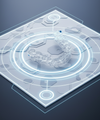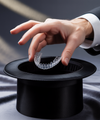5 stars reviews from dentists all around the world! ★ ★ ★ ★ ★
Recent Post
Archive
- October 2025
- July 2025
- January 2025
- November 2024
- September 2024

The problem with expansion using clear aligners
Stephane Reinhardt
Have you tried expansion with clear aligners? How is it going for you? I’m not talking about real expansion where we open the suture. Something we do with fixed appliances like a Hyrax or a Haas. I mean, arch development. I think this term is more appropriate.
Are you satisfied with what you are seeing? Does it ever happen to you that your patient is at the last aligner and all your posterior teeth are tipped buccaly? Ever wonder why? You have a posterior open bite on both sides, and this one, for sure, is not because of intrusion of the posterior teeth. And it's not because of anterior interferences (which is the case most of the time).

Even worse, sometimes you will have all the buccal cusps tipped buccaly and the palatal cusps in contact witht the lower teeth. Uuuuurrrrggghhh! Not a good day at the office. We don’t want to see that. But we look at it and we wonder: Why??? (there is a solution to this that we explain in our How to use elastics course).
You look at your ClinCheck and… this is not what you are seeing. There was no tipping planned. So how come these teeth tipped?
Well… it all goes back to mechanics! (a lot of time it does!)
First thing: we often forget that the teeth are not looking at the ClinCheck! They have no idea where to go. They are guided by one thing only: force!
They will answer to the principles of mechanics.

But not the ClinCheck or any virtual setup!
And this is often where we get confused. Because, what is a ClinCheck in reality? We see it as how the teeth will move. But that is not the case. This is where it is confusing and, a lot of times, counterintuitive. Ask me how I know!
A ClinCheck is a force system. It is how the force will be applied on the teeth. It represents the shape of all the aligners we will receive. Every stage is an appliance.
Look back at a ClinCheck where you planned expansion. I guarantee you that the teeth are moving by translation. What is a translation? It’s where all the points of an object move in the same direction at the same time.
And I’ll tell you a secret here (and you can repeat it): translation movements, I mean pure translation, are impossible in orthodontics! If you can do it, please publish.

If you understand mechanics you know why. If you don’t understand mechanics, you need to! If you want to understand how to use clear aligners, treat patient with these appliances, and incorporate tooth movement in your everyday dentistry (you should ASAP), you must understand physics and mechanics principle of tooth movement.
To create a translation, you need to apply a force directly in line with the center of resistance. Every object has a center of resistance. The center of resistance of teeth is located somewhere in the root. And we have no access to it. We can never apply a force directly in line with it.
That means that, every time we apply a force on a tooth, on the clinical crown of the tooth, we create a moment of force. That is a tendency to rotate.

When you push on the premolars and the molars to expand the arch, the will want to tip buccaly. It is the normal reacton to the force we are applying. But in the ClinCheck you will not see that. This is where you have to be a dentist and see it in your head. The more you will expand, the more you will have this secondary effect.
Depending on the initial position of the teeth, maybe this is something you want and you wish for: perfect! Those are the cases where it went well!
But if you start with a good angulation of the teeth, a good curve of Wilson, and you don’t plan any overengineering to counteract this side effect you might be in trouble.
How can we prevent that?
First, make sure you add big rectangular horizontal attachments on the buccal of the teeth you want to expand.
The attachments should be as thick as possible. Thickness is very important because this is what will bring the resistance.
You can add a small gingival bevel to help keep the tooth on track.

And finally, adding 5 degrees of buccal root torque for every mm of expansion will help you finish with the desired position. But this means that your teeth will look tippied lingually in your ClinCheck. I’m tellin you: it’s counterintuitive You will want to see the final stage of your ClinCheck with a perfect position and perfect occlusion. That will be the time to read this article again and remember yourself that a ClinCheck is a force system. It is not how the teeth will move and not how they will be positioned at the end.
I hope this helps and I wish you will have fun Making the MOVE, using expansion successfully in your future clear aligner cases.
----------------------------------------------------
If you want to learn more about mechanics and clear aligners, we got you covered. Take a look at all our courses, programs and private coaching options.
If you prefer to watch the video version of this blog, here it is!
👉 Feel free to share this article with colleagues or peers who might find it intriguing.
Let’s stay at the forefront of advancements in clear aligner technology together!
Register for our courses today and embark on a transformative learning journey with The CLEAR Institute.
You want information on our courses, programs, and services? Book some private time with Dr. Stephane Reinhardt 👉 HERE 👈
You need help with your treatment planning, go 👉 HERE 👈
You need help with your cases, and you want personalized one-on-one private coaching? Book some private time with Dr. Stephane Reinhardt 👉 HERE 👈
Take your practice to the next level with our personalized 2-day in-office coaching—tailored for you and your team to master clear aligner integration together. 👉 HERE 👈
To learn more about our online and in-person training, here are the direct links:
✅ Online courses: https://bit.ly/CLEAR_online
✅ LIVE In-person classes: https://bit.ly/CLEAR_live
✅ MOCA programs: https://bit.ly/learning_programs
✅ YouTube channel: https://bit.ly/YTCLEARsubscribe
← Older Post Newer Post →




